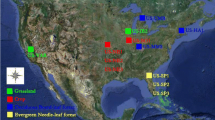Abstract
Accurate vegetation models usually rely on experimental data obtained by means of measurement campaigns. Nowadays, RET and dRET models provide a realistic characterization of vegetation volumes, including not only in-excess attenuation, but also scattering, diffraction and depolarization. Nevertheless, both approaches imply the characterization of the forest media by means of a range of parameters, and thus, the construction of a simple parameter extraction method based on propagation measurements is required. Moreover, when dealing with experimental data, two common problems must be usually overcome: the scaling of the vegetation mass parameters into different dimensions, and the scarce number of frequencies available within the experimental data set. This paper proposes the use of Artificial Neural Networks as accurate and reliable tools able to scale vegetation parameters for varying physical dimensions and to predict them for new frequencies. This proposal provides a RMS error lower than 1 dB when compared to unbiased measured data, leading to an accurate parameter extracting method, while being simple enough for not to increase the computational cost of the model.






Similar content being viewed by others
References
Radiocommunication Assembly (2013) Recommendation ITU-R P.833-8, Attenuation in Vegetation, ITU-R
Wang F, Sarabandi K (2007) A physics-based statistical model for wave propagation through foliage. IEEE Trans Antennas Propag 55:958–968
Mani F, Oestges C (2012) A ray based method to evaluate scattering by vegetation elements. IEEE Trans Antennas Propag 60:4006–4009
Alejos AV, Sánchez MG, Cuiñas I, Gómez P (2007) Depolarization effect by wind incidence on vegetation at 40 GHz. In: 2nd European conference on antennas and propagation (EuCAP 2007), pp 1–6
Gómez P, Cuinas I, Alejos A, Sánchez MG, Gay-Fernández JA (2011) Analysis of the performance of vegetation barriers to reduce electromagnetic pollution. IET Microw Antennas Propag 5(6):651–663
Picard G, Toan T, Quegan S, Caraglio Y, Castel T (2004) Radiative transfer modeling of cross-polarized backscatter from a pine forest using the discrete ordinate and eigenvalue method. IEEE Trans Geosci Remote Sens 42(8):1720–1730
Fernandes TR, Caldeirinha RFS, AL-Nuaimi M, Richter J (2005) A discrete RET model for millimeter-wave propagation in isolated tree formations. IEICE Trans Commun E88-B(6):2411–2418
Stephens RBL, Al-Nuaimi MO (1998) Measurement and prediction model optimization for signal attenuation in vegetation media at centimeter wave frequencies. IEE Proc Microw Antennas Propag 145:201–206
Richer J, Caldeirinha R, Al-Nuaimi M (2005) A generic narrowband model for radiowave propagation through vegetation. In: Proceedings of IEEE 61st vehicular technology conference (VTC Spring), vol 1, pp 39–43
Fernandes T, Caldeirinha RFS, Al-Nuaimi MO, Richter J (2006) Radiative energy transfer based model for radiowave propagation in inhomogeneous forests. In: Proceedings of the 64th IEEE vehicular technology conference (VTC 2006-Fall), vol 1, Montreal, Quebec, Canada
Ishimaru A (1997) Wave propagation and scattering in random media, IEEE Press, pp 5–93
Richter J, Al-Nuaimi MO, Caldeirinha R, Savage N (2003) RET input parameter estimation for a generic model of propagation through vegetation using excess attenuation and phase function measurements. In: 12th International conference on antennas propagation, 2003 (ICAP 2003), vol 2, No. 491, pp 836–839
Gómez-Pérez P, Caldeirinha RFS, Fernandes TR, Cuiñas I (2015) Retrieving vegetation reradiation patterns by means of artificial neural networks. IEEE Antennas Wirel Propag Lett 15(1):1097–1100
Gómez-Pérez P, Crego-García M, Cuiñas I (2016) Modeling vegetation attenuation patterns: a comparison between polynomial regressions and artificial neural networks. In: 2016 International symposium on antennas and propagation (2016 AP-S/URSI), June 26–July 1, Fajardo, Puerto Rico
Didascalou D, Younis M, Wiesbeck W (2000) Millimeter-wave scattering and penetration in isolated vegetation structures. IEEE Trans Geosci Remote Sens 38:2106–2113
Ulaby FT, Van Deventer TE, East JR, Haddock TF, Coluzzi ME (1988) Millimeter-wave bistatic scattering from ground and vegetation targets. IEEE Trans Geosci Remote Sens 26(3):229–243
Balanis CA (2005) Antenna theory: analysis and design, 2nd edn. Wiley, Hoboken, pp 60–63
Bishop CM (1995) Neural networks for pattern recognition. Oxford University Press, USA, pp 77–100
Kecman V (2001) Learning and soft computing, support vector machines, neural networks, and fuzzy logic models. The MIT Press, Cambridge
Acknowledgements
Research partially supported by the Portuguese Government, Portuguese Foundation for Science and Technology (FCT); the University of South Wales, United Kingdom; Spanish Government, Ministerio de Economía y Competitividad, Secretaría de Estado de Investigación, Desarrollo e Innovación (project TEC2014-55735-C03-3R); AtlantTIC Research Center, the European Regional Development Fund (ERDF) and Xunta de Galicia (Project GRC1015/019).
Author information
Authors and Affiliations
Corresponding author
Rights and permissions
About this article
Cite this article
Gómez-Pérez, P., Caldeirinha, R.F.S., Fernandes, T.R. et al. Using artificial neural networks to scale and infer vegetation media phase functions. Neural Comput & Applic 29, 1563–1574 (2018). https://doi.org/10.1007/s00521-016-2778-6
Received:
Accepted:
Published:
Issue Date:
DOI: https://doi.org/10.1007/s00521-016-2778-6




